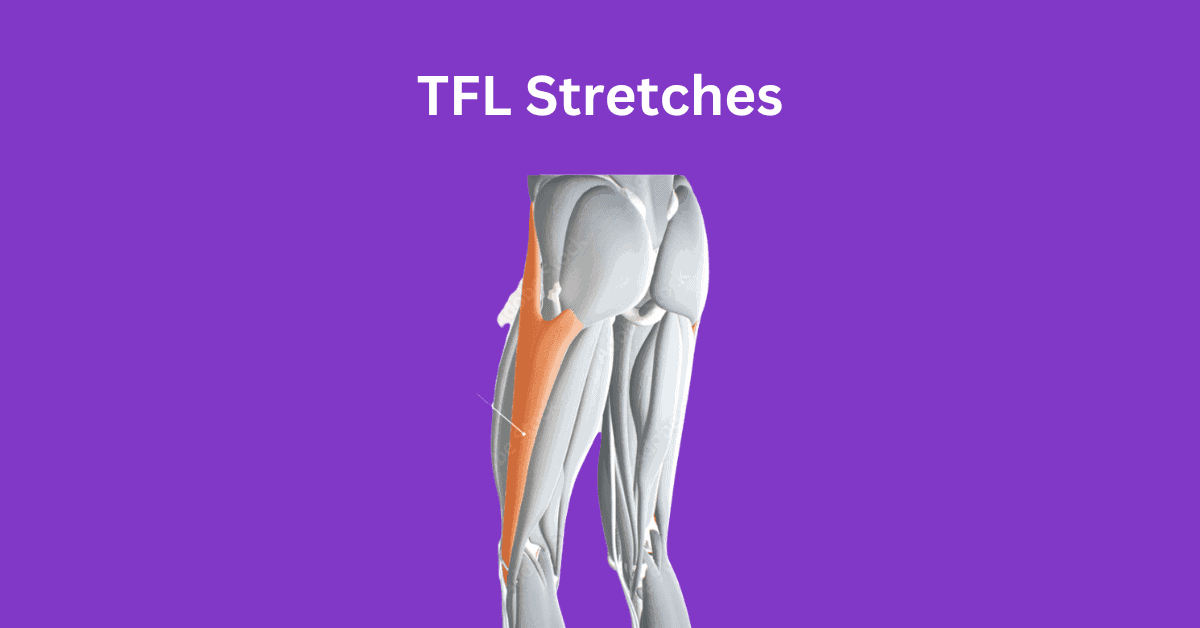10 Best TFL stretches: Release Tension Effectively

Simply doing TFL stretches regularly can help ease symptoms of your hip pain & lower back pain.
In most cases TFL is a foreign muscle for many individuals, therefore it doesn’t receive any attention or love.
In this content, I will review the best TFL stretches, how to perform them correctly, test to find out if your TFL is tight, and the causes of TFL tightness.
What Is The TFL?
The TFL or Tensor Fasciae Latae for full abbreviation, is a small but essential muscle.
It’s located in the outer hip region, specifically on the upper and outer part of the thigh. It’s situated just below your hip bone and extends down the side of the thigh.
The TFL is involved in many bodily movements, these include:
- Hip flexion– assisting you in raising your thigh toward the chest.
- Abduction– helping you move your leg away from the body’s midline.
- Internal rotation– it aids in turning your thigh inward.
- Stabilization– the TFL plays a role in stabilizing the hip joint and pelvis during various movements such as walking, running, and standing.
If the TFL becomes tight or overactive, it can lead to issues like hip pain, lower back pain, and IT band syndrome.
In this case, stretching and releasing tension in the TFL muscle through various stretches which I will go over can be beneficial for relieving hip and lower back discomfort.
How To Know If Your TFL Muscle Is Tight?
Before you do a TfL stretch, you should identify that the TFL is actually tight. If the targeted muscle is not tight, stretching it won’t be that effective for easing your symptoms.
Ober Test
- You need someone to help you with this test.
- Lie on the side of your body.
- Have them place one hand on your pelvis for stabilization and the other on your inner knee.
- While keeping your leg straight, they will abduct your leg around 90 degrees.
- Have them lift the leg up and back down on the bench
- Repeat the same movement on your other leg.
If you can’t lower the leg back down, it shows you have tightness within the TFL muscle.
Thomas Test
- Lie flat on your back
- Lift one leg up, and using your hands, pull the knee towards your chest.
- Try not to force any movements and keep your body relaxed. Your job is to observe your other leg.
- As you bring the knee closer to your chest, if your other leg starts to move to the side or the knee starts elevating, you might have tightness in your TFL.
What Are The Best TFL Stretches?
In this section I will go over some unique TFL stretches you can perform easily right from home.
Standing TFL Stretch
- Stand side by side at arm width against the wall.
- Use your left arm to slightly lean on the wall.
- Bring your left foot behind your right foot.
- While keeping your right leg stiff, lean your left hip towards the wall.
- Hold for 30 seconds and repeat on the other side.
Iron Cross Stretch
- Lay flat on the floor with your back.
- Bring your feet together and your hands to the side to make a T shape with your body.
- Lift one leg up and reach across the opposite side as far as you can, by twisting your lower back & hips.
- Make sure to keep every body part above your lower back flat on the floor.
- Hold for 30-60 seconds and repeat this on the other side.
Supine TFL Stretch
- Lay flat on your back.
- Slide your right foot towards your body until it’s flat on the ground.
- Lift your left foot and rest it on the top of your right knee.
- Place both hands on the floor and twist to your left.
- Hold for 20 seconds and repeat the movement on your other side.
Kneeling TFL Stretch
- Get down on your left knee and move your right foot in front of the left knee.
- Have an upright posture and slightly lean backward.
- Slowly drop your hips forward and outwards to the left side until you feel a stretch.
- Hold for 30 seconds and repeat on your right side
TFL Release With A Ball
- Get yourself a small compact ball, this can be a tennis ball, lacrosse ball, or baseball.
- Lay face down on your belly.
- Place the ball on the top outer part of your thigh.
- Gently lean your weight toward that side and move your leg from side to side.
- You can also roll the ball up and down to find a tender spot.
- Hold the position until you feel the muscle loosen up and switch sides.
Lying TFL Stretch
- Lay on your side on the edge of your bed.
- Use one of your hands as a headrest if needed.
- Lift your top leg up and extend it behind your body.
- Make sure to avoid twisting your upper body during the stretch.
- Hold the position for 30-40 seconds.
Kneeling Lunge
- Get down on one knee ( you can place a soft object like a pillow below the knee).
- Place your other foot in front of the knee so they are in line with each other.
- Have an upright position.
- While maintaining the upright position slowly lean your weight against your front foot until you feel a deep stretch.
- Hold for 20-40 seconds and switch legs.
Assisted TFL Stretch
- Find something you can hold on to~ this can be a wall or a table.
- Move your right foot in front of your left foot.
- Slightly point your left toe inwards (towards the right side).
- Gradually drive your left hip at a 45-degree angle.
- Hold for 40-60 seconds.
- Repeat the same on the other side.
TFL Twister
- Get down on a kneeling lunge position, with your right knee down.
- With your left hand grab your right foot and place your right hand on the ground to help balance your body.
- Slowly twist your torso to the left.
- Hold for 20-30 seconds and switch sides.
Seated TFL Stretch
- Sit down on a chair with an upright position.
- Lift your left foot up and rest the ankle on your right thigh.
- Hold your left knee with both hands and pull it towards your chest, while slightly twisting your upper body.
- Pull your knee as close as possible without feeling any pain or compromising your form.
- Hold for 20-40 seconds and repeat on the other leg.
What Are The Causes Of Tight TFL?
Sedentary Lifestyle
When you sit for a prolonged period such as in a desk job or while watching TV, your TFL gets put in a shortened position. Over time, the TFL adapts to being in this shortened position, causing it to become tight.
Also, a sedentary lifestyle typically involves minimal hip movements. As the TFL is responsible for hip flexion and abduction, when these movements are rarely engaged, the TFL can lose flexibility.
Poor Posture
A poor posture in most cases involves an anterior pelvic tilt, where the pelvis tilts forward and downward. This places added strain on the TFL as it tries to compensate for the imbalance, contributing to muscle tightness.
Furthermore, poor posture can result in uneven weight distribution on the hips and legs. Having this imbalance puts extra strain on the TFL.
Overuse
If you’re someone who loves to do outdoor activities that involve repeated hip flexion and abduction movements, such as running or cycling, you need to make sure you’re not overworking the muscles.
Focus on recovery by eating nutritious meals, keeping hydrated, getting enough, and performing regular stretches.
Muscle Imbalances
Having weakness in certain muscle groups like the gluteal, particularly the gluteus medius can contribute to TFL tightness.
When the glutes are underactive or weak, your body may heavily rely on the TFL to provide stability and support during various movements like squatting, running and even standing up.
The TFL has to compensate for the weakness, so it gets overworked.
What Is The Function Of The TFL?
Even though TFL is a smaller muscle, it’s still important for various movements:
- Hip Flexion- The TFL assists in flexing the hip joint, which involves lifting the thigh towards the chest.
- Hip Abduction- The TFL is responsible for moving the leg thigh away from the body’s midline~ this motion is known as abduction.
- Hip Internal Rotation- The TFL also contributes to the internal rotation of the hip joint, which involves turning the thigh inward.
- Stabilization of the Hip and Pelvis: The TFL is one of the muscles required for stabilizing the hip joint and pelvis~ supporting in keeping proper alignment of the pelvis and preventing excessive lateral tilt or drop of the pelvis.
- Assistance In Posture– TFL helps maintain an upright posture by helping to stabilize the pelvis and control the hip position.
These movements are all required to work in conjunction with each other to allow optimal motion for daily activities like walking and climbing up stairs.
Conclusion
Hope by now you were able to learn a little more about the TFL muscle and its critical value within our body.
It’s important to note that the TFL can get easily overworked if you have weakness within certain muscle parts, so you should perform regular stretches to prevent tightness from occurring.
But before you go ahead with the TFL stretches, you should test if the muscle is tight in the first place.
For healthy hips remember to give your TFL some TLC – Tender Loving Stretch!



